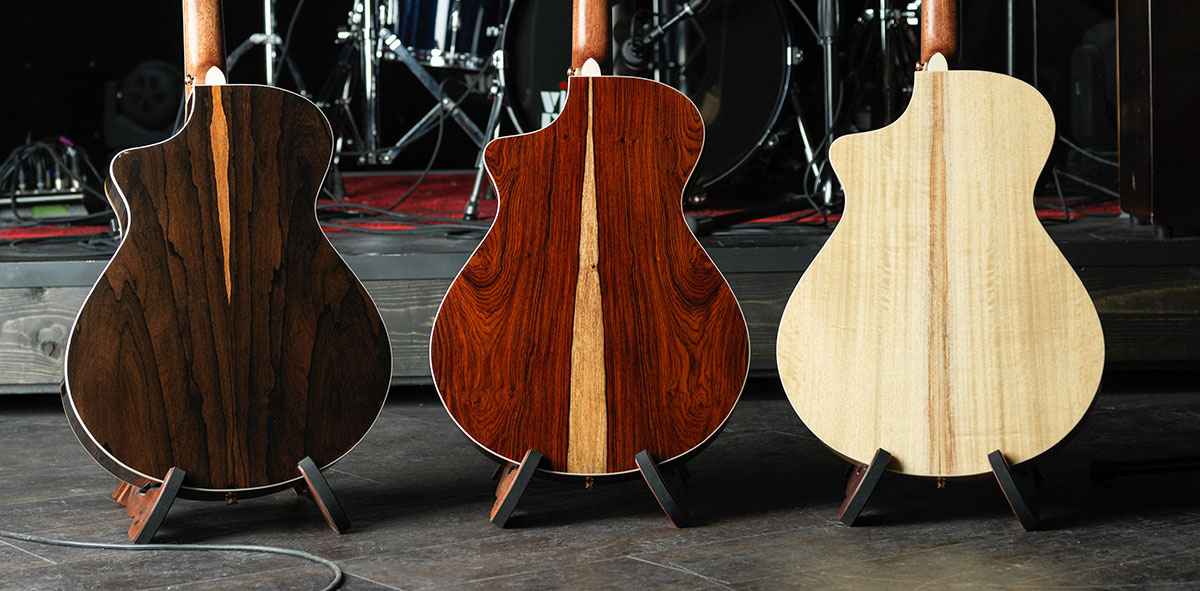
There are endless kinds of tonewoods that are great for building guitars with. Some are preferred, and have different benefits for different purposes. Some tonewoods lend themselves well to strumming or flatpicking, and give out a better sound. We choose a smattering of tonewoods that we use to create Breedlove Guitars, and broke down their benefits.
Brazilian Rosewood
Any type of rosewood is rare and heavily regulated. Most species were ruled as endangered, with Brazilian Rosewood designated as endangered in 1964. It is illegal to harvest, and most acoustic guitars being built today are using wood that was harvested before the 1964 ban. All rosewood should come with certified CITIES paperwork, noting that the wood was legally harvested. If a guitar is without CITIES paperwork, it is likely that the wood is illegal.
Rosewood comes in many shades, from burnt orange, to dark brown and some almost violet hues. Rosewood gets its name from it’s almost floral scent, reminiscent of roses. As far as sound is concerned, Brazilian Rosewood is one of the finest tonewoods, with a perfect glass-like ring. It creates sound that really resonates with clarity. It features a louder and warm tone, with fuller bass and treble notes.
Indian Rosewood
This rosewood is more popular than Brazilian rosewood. It’s a more neutral wood, with a well-balanced sound that works well in dreadnoughts. It can be used well with bass notes, and clearer treble notes.
Bubinga
This tonewood is typically found in reddish bronze colors, much like Indian rosewood. This wood is much denser than rosewood, but has great sound clarity. With warmer tones, and a brighter midrange than most this is growing in popularity as an acoustic guitar tonewood. This African tonewood is harder and heavier than Brazillian or Indian rosewood.
Cocobolo
Cocobolo features a well-balanced tone that offers great power, sustainability and tons of volume. A unique aspect of this tonewood is it’s slowly-decaying harmonics, with notes that ring longer than most. Tonally, Cocobolo is closer to Brazillian tonewood, coming in with a complex lower end of sound. This tonewood can be found in red brown tones, with black streaks.
Maple
Maple is another tonewood that does really with harmonics. Another hardwood, Maple is perfect for big bodied guitars, meant for strumming.
Sitka Spruce
Grown in the Northwest, Sitka Spruce is one of the most popular tonewoods for USA made instruments. This is a very strong wood, but it’s light, and perfect for flatpicking styles of playing. This tonewood does take it’s time to open up, and is found in whites and pinks to light browns.
Koa
Koa is a wonderfully golden tonewood, offering sweeter and clearer tones than most. This tonewood opens up and grows sweeter with time, which is one of its most desired benefits. With a richer midrange tone, this tonewood has risen in price in recent years. It’s harder to find top quality Koa.
Koa is a stiff wood, like rosewood, but offers a warmer sound much like mahogany. This wood, ironically, is fast growing, and native to the Hawaiian Islands. It requires 200 inches of rainfall annually, and grows really well in volcanic soil.
